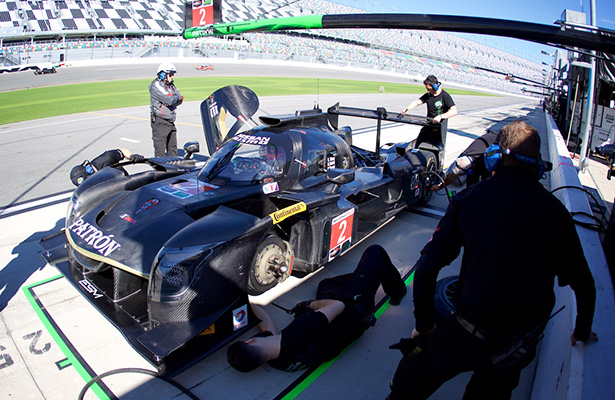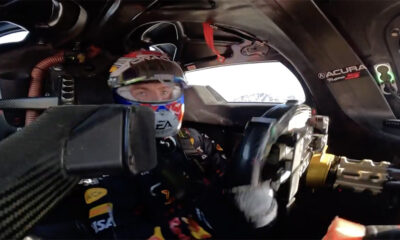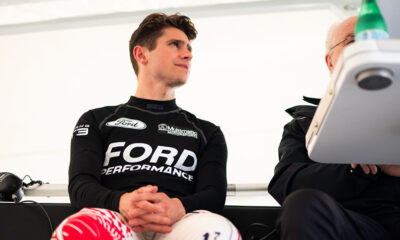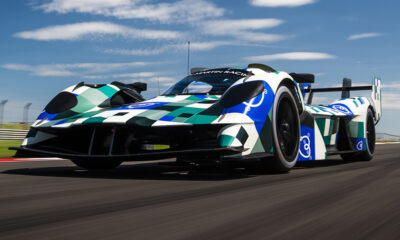
Photo: John Dagys
Onroak Automotive team principal Philippe Dumas has revealed that roughly 60 percent of Tequila Patron ESM’s new Nissan Onroak DPi features different components from its LMP2-spec Ligier JS P217 Gibson.
Both of the Onroak-built DPi and LMP2 cars are set for their competition debuts in this month’s Rolex 24 at Daytona, in what’s proven to be a massive technical exercise for the French constructor.
“More or less, everything is different with the car,” Dumas told Sportscar365. “60 percent of the car [is different from the JS P217].
“The balance is different. Some parts of the gearbox are different. The engine, the floor, the sidepods, the front, the rear bonnet… everything is different.
“It was a big challenge because if you take a Mazda or Cadillac, they started the project with this and they built it after the WEC car. We did the opposite.
“It’s part of the game and its very good to have this relationship with Nissan.”
Dumas said packaging the Japanese manufacturer’s 3.8-liter twin-turbo V6 powerplant, derived from the Nissan GT-R NISMO GT3, has been one of the biggest challenges, particularly with the time constraints they’ve been up against.
The green light for the Nissan DPi program was only given in September, compared to the Cadillac and Mazda’s efforts, which have each been more than a year in development.
“It was [also] a huge challenge because it was the first time that a GT3 engine is inside a prototype,” Dumas said. “It’s quite new and probably good for the future because it’s a GT3 engine.
“Can you imagine the space with the turbocharger, the weight, and everything? That is very new.”
Dumas said weight distribution has also been a key difference between the two prototypes, with the production-based Nissan powerplant some 50kg heavier than the normally aspirated Gibson GK428 V8.
While the JS P217 carries ballast to meet the 930kg minimum weight, Dumas admitted the Nissan DPi is currently slightly overweight.
“It was a challenge but of course at the moment we have something to learn,” he said. “We have to work on our side and especially on NISMO’s side to get a competitive weight.
“When you talk about a 50-kilo difference, especially on the rear, and when you look at the engine, the weight is at the worst place. It’s very high. So, the weight distribution is so different.
“The geometry is the same, the chassis is the same, the brakes are the same. So we [share] some information [between the two cars] for sure.
“It’s new and not new at the same time because we have this nearly exact same [situation] between the JS P2 Nissan and the JS P2 Honda.”
While critics have stated the Nissan GT-R-inspired bodywork is only marginally different than the standard JS P217 aero, Dumas admitted it’s only a “first step.”
The most visible feature on the Nissan DPi is the reshaped nose and revised cooling ducts on the sidepods.
“You had to find a compromise and work together because the project was so late,” Dumas said. “IMSA needed to give us a little bit of room, the same for Nissan.
“My aim is to give confidence to Nissan that the championship is going well and they see that it’s important to be there, and I’m confident in it.
“So if it’s a case, for sure Nissan will bring more support and a little different design.”
While Dumas ruled out a design update for this year, IMSA rules allow manufacturers to submit bodywork updates or entire new designs for approval at any time, although it would have to go through the entire homologation process again.
With ESM having a two-year exclusivity contract for the Nissan Onroak DPi, Dumas is hopeful of bringing additional manufacturers into DPi fold with Onroak in the years to come.
“We were the first, and it’s true, to make a [LMP2 fully compatible] with a Judd, Nissan and HPD engine,” he said. “It would [have been] impossible to win Daytona and Sebring [without the HPD engine].
“With this experience with Nissan, I think everybody will see that we are able to work on different projects. I think it’s a good opportunity to find another one with an Onroak chassis.”






















